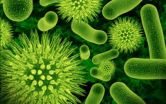(Press-News.org) New research from the Massachusetts Institute of Technology reveals that some unlikely subjects--bacteria--can have social structures similar to plants and animals.
The research shows that a few individuals in groups of closely related bacteria have the ability to produce chemical compounds that kill or slow the growth of other populations of bacteria in the environment, but not harm their own.
Published in the September 7 issue of the journal Science, the finding suggests that bacteria in the environment can play different social roles and that competition occurs not only among individual bacteria, but also among coexisting ecological populations.
The National Science Foundation, an independent federal agency that supports fundamental research and education across all fields of science and engineering, funded the research.
"Bacteria typically have been considered purely selfish organisms and bacterial populations as groups of clones," said Otto Cordero, a theoretical biologist and lead researcher on the paper. "This result contrasts with what we know about animal and plant populations, in which individuals can divide labors, perform different complementary roles and act synergistically."
Cordero and colleagues from MIT, along with researchers from the French Research Institute for Exploitation of the Sea and Woods Hole Oceanographic Institution in Massachusetts, studied whether population-level organization exists for bacteria in the wild.
They reasoned social structure can reduce conflict within populations of plants and animals and determine aggression towards competing biological populations. "Think of a population of lions in the Serengeti or a population of fish in a lake," said Cordero. But could the same be true for populations of bacteria?
"It is difficult to know what the environmental interactions really are, because microbes are too small for us to observe them in action," said Martin Polz, an organismic and evolutionary biologist at MIT and principal investigator for the Polz Microbial Ecology and Evolution Lab. "But our research provides strong evidence that antibiotics play a role in fending off competitors."
The researchers found evidence by looking at direct, aggressive competition between ecological populations of bacteria. They reconstructed a large network of bacterial fights--or antibiotic-mediated interactions--between bacteria from the ocean.
The scientists analyzed interactions called interference competitions, wherein bacteria produce antibiotics as a means of chemical warfare, to gain a competitive edge by directly hindering the survival of potential competitors.
This typically occurs when bacteria compete for the same portion of habitat.
The researchers assembled an all-against-all battleground for 185 closely-related, but distinct, members of an ocean-based family of bacteria called Vibrionaceae. They measured bacterial compounds produced by Vibrio isolates that directly antagonized other Vibrio isolates.
The framework provided Cordero and colleagues an opportunity to examine about 35,000 possible antibiotic-mediated interactions.
The researchers found that ecologically delineated bacterial populations act as socially cohesive units. "In these populations, a few individuals produced antibiotics to which closely related individuals in the population were resistant, whereas individuals in other populations were sensitive," said Cordero.
Thus, aggressive chemical reactions occur between, rather than within natural populations.
"It appears to be a group effort where individuals assume the role of antibiotic producers and hence defenders," said Polz. "Of course, competing groups could also produce antibiotics. It's a potential arms race out there."
"Those individuals that don't produce antibiotics can benefit from association with the producers, because they are resistant," added Cordero. "In other words, antibiotics have a social effect, because they can benefit the population as a whole."
The findings may help scientists answer questions about the natural role of antibiotics in human contexts.
"The research has the potential to bridge gaps in our understanding of the relationships between plants and humans and their non-disease- and disease-causing bacterial flora," said Robert Fleischmann, a program director in the Division of Biological Infrastructure for the National Science Foundation.
"We use antibiotics to kill pathogenic microbes, which cause harm to humans and animals," said Polz. "As an unfortunate side effect, this has lead to the widespread buildup of resistance, particularly in hospitals where pathogens and humans encounter each other often."
In addition, the results help scientists make sense of why closely related bacteria are so diverse in their gene content. Part of the answer, they say, is that the diversity allows the bacteria to play different social roles.
Social differentiation, for example, could mitigate the negative effects of two species competing for the same limiting resource--food or habitat, for instance--and generate population level behavior that emerges from the interaction between close relatives.
"Microbiology builds on the study of pure cultures," said Cordero, "that is genotypes isolated from their population. Our work shows that we need to start focusing on population based phenomena to better understand what these organisms are doing in the wild."
INFORMATION:
New research suggests bacteria are social microorganisms
MIT scientists: Bacteria plays different social roles, including attacking and defending other bacteria
2012-09-08
ELSE PRESS RELEASES FROM THIS DATE:
Racial and ethnic diversity spreads across the country
2012-09-08
Increasing racial and ethnic diversity has long been apparent at the national level and in our nation's largest metropolitan gateways. Since 1980 over nine-tenths of all cities, suburbs and small towns have become more diverse. And rural communities are following the lead of their urban counterparts, according to a U.S. 2010 policy brief.
"What really stands out is the near-universal nature of the trend toward greater racial and ethnic diversity at the local level," said Barry Lee, professor of sociology and demography, Penn State, and co-author of the brief.
Another ...
Precautions for tick-borne disease extend 'beyond Lyme'
2012-09-08
This year's mild winter and early spring were a bonanza for tick populations in the eastern United States. Reports of tick-borne disease rose fast.
While Lyme disease is the most common tick-borne disease in the Northeast and Upper Midwest, new research results emphasize that it is not the greatest cause for concern in most Southeastern states.
The findings are published today in a paper in the journal Zoonoses and Public Health.
The majority of human-biting ticks in the North--members of the blacklegged tick species--cause Lyme disease, but these same ticks do not ...
NASA sees Hurricane Leslie's eye close
2012-09-08
Hurricane Leslie appeared to "close its eye" on NASA satellite imagery as the storm heads east of Bermuda, like a little girl shutting her eyes tight on a wild amusement ride. Often when an eye becomes cloud-filled, its a sign that the storm is weakening, and Leslie did drop from a hurricane to a tropical storm on Sept. 7.
The Moderate Resolution Imaging Spectroradiometer (MODIS) instrument aboard NASA's Terra satellite captured a visible image of Hurricane Leslie on Sept. 6 at 10:45 a.m. EDT and Leslie's eye appeared cloud covered. Leslie went on to weaken to tropical ...
Clearer look at how iron reacts in the environment
2012-09-08
ARGONNE, ILL. (Sept. 6, 2012) -- Using ultrafast X-rays, scientists for the first time have watched how quickly electrons hop their way through rust nanoparticles.
This gives key insight to how iron oxide, one of the most abundant minerals in soil, behaves and alters the condition of soil and water around it. This also demonstrates the potential of time-resolved X-ray and optical methods to study chemical reactions at the subnanoscale in other semiconductors.
Scientists have long known that certain minerals, redox active ions and biological proteins can exchange electrons ...
Tailgaters contribute to team victory and even university brand, Notre Dame study shows
2012-09-08
As tailgaters everywhere ramp up for another weekend of college football, University of Notre Dame marketing professor and cultural anthropologist John Sherry has just concluded first-of-its-kind research that shows those huge pre-game parking lot parties build community, nurture tradition, and actually contribute to a school's brand—at least for the fans.
In their study, "A Cultural Analysis of Tailgating," Sherry and co-author Tonya Bradford, assistant professor of marketing at Notre Dame, examine American culture and our obsession with football, which Sherry calls "the ...
Notre Dame astrophysicists publish new approach to cosmic lithium in the early universe
2012-09-08
J. Christopher Howk, Nicolas Lehner and Grant Mathews of the Center for Astrophysics at the University of Notre Dame published a paper this week in the journal Nature titled "Observation of interstellar lithium in the low-metallicity Small Magellanic Cloud." The astrophysicists have explored a discrepancy between the amount of lithium predicted by the standard models of elemental production during the Big Bang and the amount of lithium observed in the gas of the Small Magellanic Cloud, a galaxy near to our own.
"The paper involves measuring the amount of lithium in the ...
The nose knows: Gene therapy restores sense of smell in mice
2012-09-08
A team of scientists from Johns Hopkins and other institutions report that restoring tiny, hair-like structures to defective cells in the olfactory system of mice is enough to restore a lost sense of smell. The results of the experiments were published online this week in Nature Medicine, and are believed to represent the first successful application of gene therapy to restore this function in live mammals.
An expert in olfaction, Randall Reed, Ph.D., professor of molecular biology and genetics and co-director of the Center for Sensory Biology at the Johns Hopkins Institute ...
Coping skills, marital satisfaction help pregnant moms manage stress when fetus has heart defect
2012-09-08
Expectant mothers who learn from prenatal diagnosis that they are carrying a fetus with a congenital heart defect (CHD) commonly suffer post-traumatic stress, depression and anxiety. However, a healthy relationship with one's partner and positive coping mechanisms can reduce this intense stress, according to new research from the Cardiac Center of The Children's Hospital of Philadelphia.
The study is published in the September 2012 issue of The Journal of Pediatrics.
"Receiving the news of carrying a fetus with a CHD is a stressful event which can potentially influence ...
UC Santa Cruz study shows how sea otters can reduce CO2 in the atmosphere
2012-09-08
Can an abundance of sea otters help reverse a principal cause of global warming?
A new study by two UC Santa Cruz researchers suggest that a thriving sea otter population that keeps sea urchins in check will in turn allow kelp forests to prosper. The spreading kelp can absorb as much as 12 times the amount of CO2 from the atmosphere than if it were subject to ravenous sea urchins, the study finds.
The theory is outlined in a paper released online today (September 7, 2012) in Frontiers in Ecology and the Environment by lead authors UC Santa Cruz professors Chris Wilmers ...
Subsidies change incentives for adoption of foster children: Study
2012-09-08
The structure of a federal program that provides monthly subsidies to promote the adoptions of special needs children in foster care may actually be delaying some adoptions, according to a new study by University of Notre Dame economist Kasey Buckles.
The Adoption Assistance and Child Welfare Act (AACWA), passed in 1980, provides an average of $670 per month for foster parents of special needs children, while adoptive parents of special needs children receive an average of $571 per month. "Special needs" refers to foster children who may be harder to place ...
LAST 30 PRESS RELEASES:
Plant hormone allows lifelong control of proteins in living animal for first time
Swedish freshwater bacteria give new insights into bacterial evolution
Global measures consistently underestimate food insecurity; one in five who suffer from hunger may go uncounted
Hidden patterns of isolation and segregation found in all American cities
FDA drug trials exclude a widening slice of Americans
Sea reptile’s tooth shows that mosasaurs could live in freshwater
Pure bred: New stem cell medium only has canine components
Largest study of its kind highlights benefits – and risks – of plant-based diets in children
Synergistic effects of single-crystal HfB2 nanorods: Simultaneous enhancement of mechanical properties and ablation resistance
Mysterious X-ray variability of the strongly magnetized neutron star NGC 7793 P13
The key to increasing patients’ advance care medical planning may be automatic patient outreach
Palaeontology: Ancient tooth suggests ocean predator could hunt in rivers
Polar bears may be adapting to survive warmer climates, says study
Canadian wildfire smoke worsened pediatric asthma in US Northeast: UVM study
New UBCO research challenges traditional teen suicide prevention models
Diversity language in US medical research agency grants declined 25% since 2024
Concern over growing use of AI chatbots to stave off loneliness
Biomedical authors often call a reference “recent” — even when it is decades old, analysis shows
The Lancet: New single dose oral treatment for gonorrhoea effectively combats drug-resistant infections, trial finds
Proton therapy shows survival benefit in Phase III trial for patients with head and neck cancers
Blood test reveals prognosis after cardiac arrest
UBCO study finds microdosing can temporarily improve mood, creativity
An ECOG-ACRIN imaging study solves a long-standing gap in metastatic breast cancer research and care: accurately measuring treatment response in patients with bone metastases
Cleveland Clinic presents final results of phase 1 clinical trial of preventive breast cancer vaccine study
Nationally renowned anesthesiology physician-scientist and clinical operations leader David Mintz, MD, PhD, named Chair of the Department of Anesthesiology at the UM School of Medicine
Clean water access improves child health in Mozambique, study shows
Study implicates enzyme in neurodegenerative conditions
Tufts professor named Fellow of the National Academy of Inventors
Tiny new device could enable giant future quantum computers
Tracing a path through photosynthesis to food security
[Press-News.org] New research suggests bacteria are social microorganismsMIT scientists: Bacteria plays different social roles, including attacking and defending other bacteria




